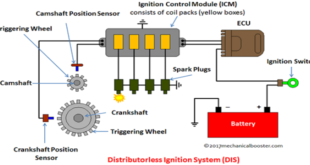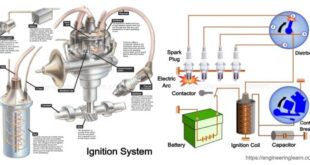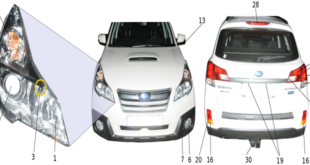Introduction
For starting the engine we have to crank the engine. The starting system is used for this purpose. The unit illustrates the circuit of this system. It deals with the construction and working of starting motors and also describes the types of starter drive and their working. The students will be able to know the construction and working of solenoid switches and also will be capable of servicing the starting system.
Starting system
Starting system uses battery power and an electric DC motor to turn the engine crankshaft for engine starting. It changes electrical energy to mechanical energy. It provides gear reduction/torque multiplication (16:1 to 20:1). When the ignition key is turned on the current flows through the solenoid coil, this closes the contacts, connecting the battery to the starter motor.
Starting circuit
The starting system includes the battery, starter motor, solenoid, ignition switch and in some cases, a starter relay. An inhibitor (neutral safety) switch is included in the starting system circuit to prevent the vehicle from being started while in gear.
When the ignition key is turned to the start position, the current flows and energizes the starter’s solenoid coil. The energized coil becomes an electromagnet which pulls the plunger into the coil; the plunger closes a set of contacts which allows a high current to reach the starter motor. On models where the solenoid is mounted on the starter, the plunger also serves to push the starter pinion to mesh with the teeth on the flywheel.
Starter motor
A starter motor is used to crank the engine. It works on the principle “like magnetic poles repel each other.” When a current-carrying coil is placed in a magnetic field, it will produce a force in the coil and this causes the coil to rotate. The motor must be powerful enough to turn the engine to start. It must be capable of exerting a very heavy torque when starting and at low speeds. For this purpose, the starter motor is usually a series wound. Currently, series shunt-wound motors are also used.
Armature assembly
The armature assembly consists of an armature shaft, armature core, commutator, and armature windings. The armature shaft supports the armature assembly as it spins inside the starter housing. The armature core is made of iron and holds the armature windings in place. The commutator serves as a sliding electrical connection between the motor windings and the brushes and is mounted on one end of the armature shaft.
The commutator has many segments that are insulated from each other. As the windings rotate away from the pole shoe (piece), the commutator segments change the electrical connection between the brushes and the windings. This action reverses the magnetic field around the windings. The constant changing electrical connection at the windings keeps the motor spinning.
Commutator end frame
The commutator end frame houses the brushes, the brush springs, and the armature shaft bushing. The brushes ride on top of the commutator. They slide on the commutator to carry the battery current to the spinning windings. The springs force the brushes to maintain contact with the commutator as it spins, thereby no power interruptions occur. The armature shaft bushing supports the commutator end of the armature shaft.
Field frame
The field frame is the center housing that holds the field coils and pole shoes. The field coil (winding) is a stationary set of windings that creates a strong magnetic field around the motor armature. When current flows through the winding, the magnetic field between the pole shoes becomes very large. This acts against the magnetic field created by the armature, which spins the motor with extra power. Field windings vary according to the application of the starter motor.
Last word
The drive end frame is designed to protect the drive pinion from damage and to support the armature shaft. The drive end frame of the starter contains a bushing to prevent wear between the armature shafts and drive end frame.
 NEWSHUNTS
NEWSHUNTS



